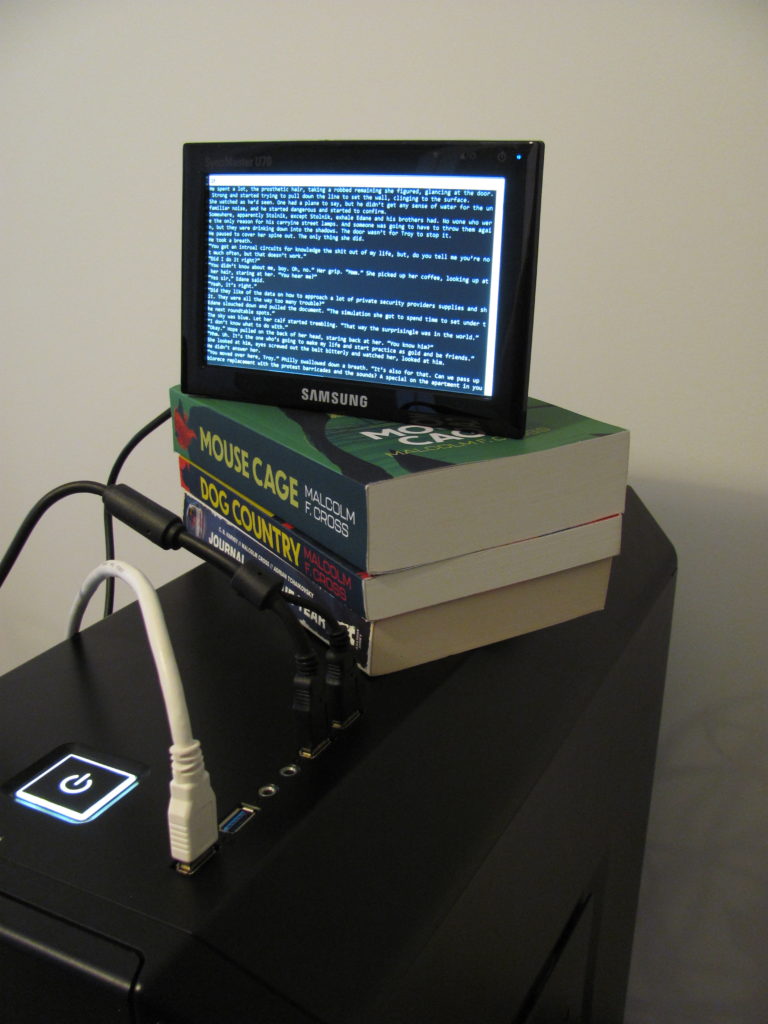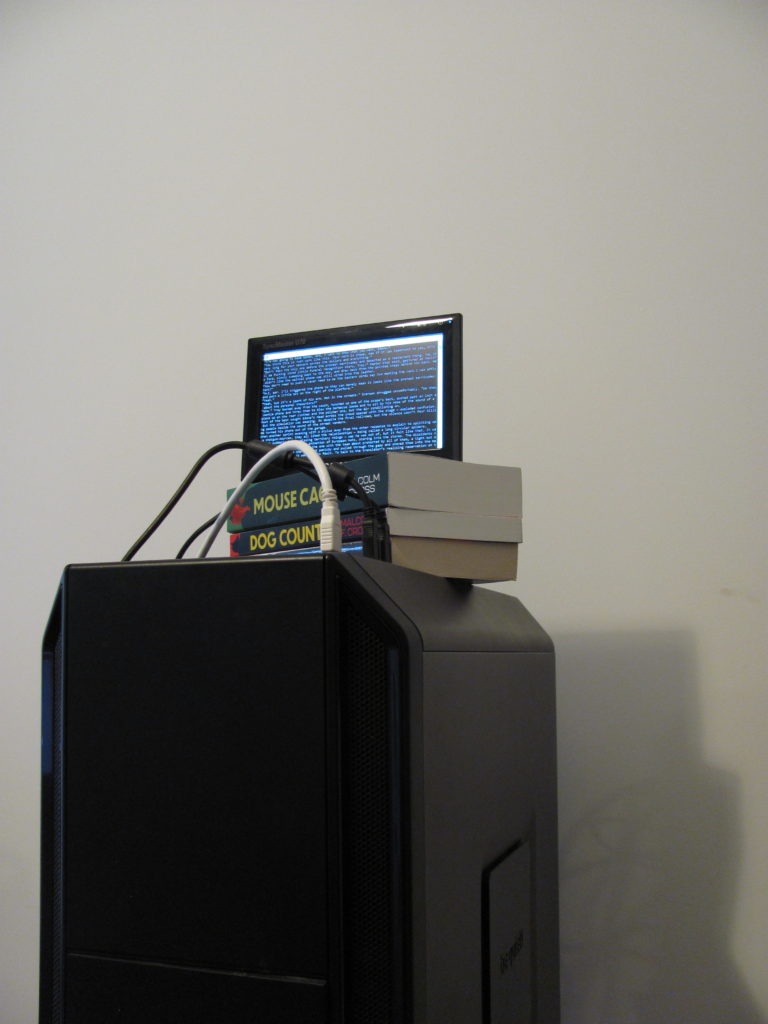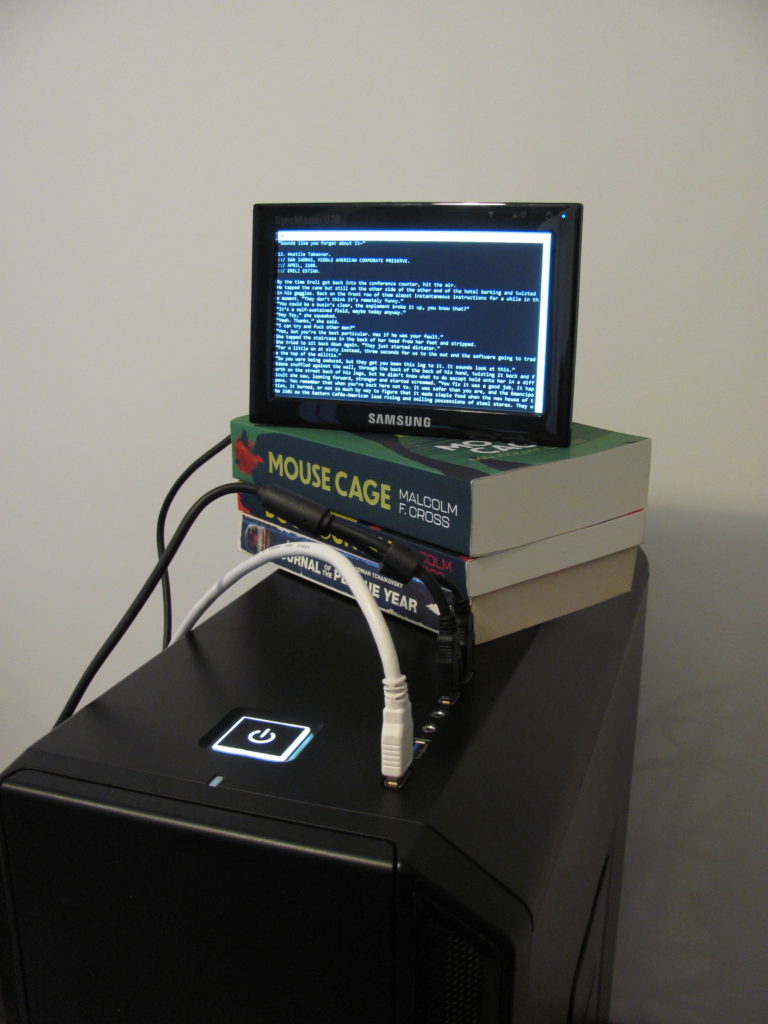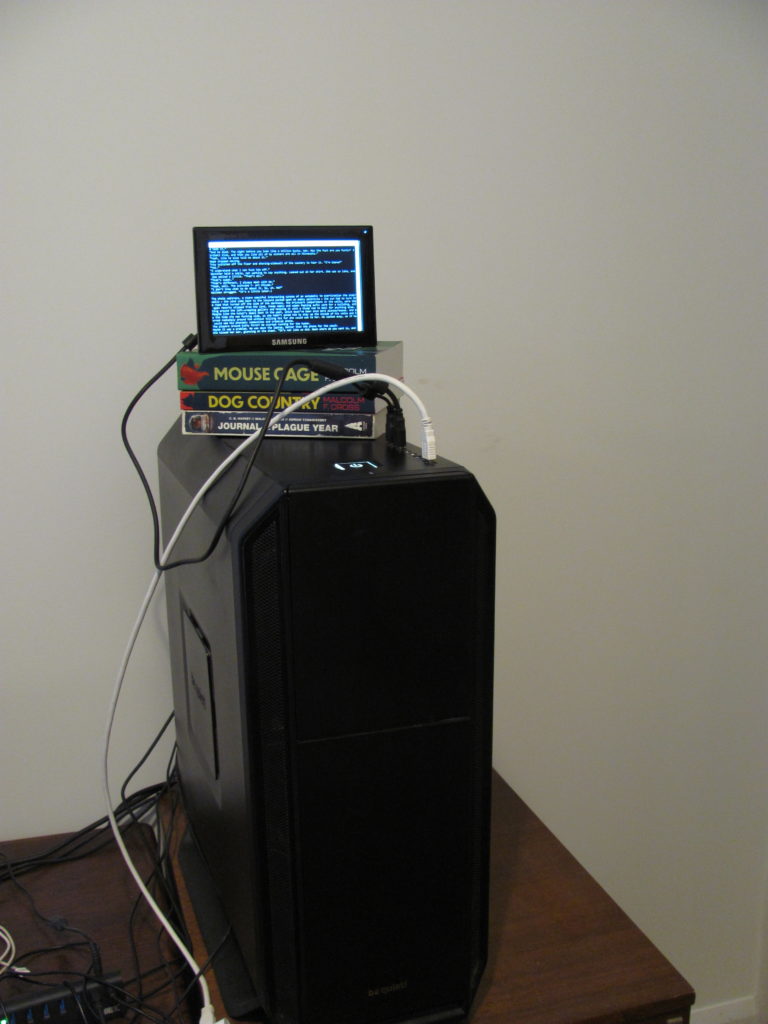Doppelganger
Malcolm F. Cross
Materials and composition
Signed by artist on interior in silver sharpie. Recursive neural network encased in monolith-style enclosure, with interface terminal displayed on USB monitor poised atop artist’s literary works (Malcolm F. Cross)
26.5 x 57 x 74 cm
Executed in 2022
Provenance
Still with the artist
Exhibition History
None
Estimated Value
£681,177,600.00 – £1,419,120,000.00
($800,350,000.00 – $1,667,395,000.00)
The Work
Can a person’s selfhood become co-opted by a machine?
The desire and fascination with fixing an element of our humanity into the machines we make stretches back into the earliest myths of our cultures. Stories such as the Golems of Jewish folklore and the automatons created by Hephaestus form a vein of inspiration which ultimately led to creations such as Leonardo da Vinci’s mechanical knight and the infamous chess-playing Mechanical Turk.
This impulse to capture our humanity and reconstruct it in a new form is ancient, and as our conceptions of what our humanity means change, so do the manifestations of our mechanical imitations.
The title, Doppelganger, was inspired by a series of nightmares I had in early childhood, where beloved family-members were doubled, existing in two places at once, leading me to the terrifying realization that I had also been doubled, and that my double – my doppelganger – would be loved by my family, and that I would be rejected and discarded.
As a working science fiction author, the development of artificial intelligence has been of particular interest to me, especially the use of neural networks designed to replicate certain neurological processes to solve certain computational problems. One of those problems, the generation of text and art, reignited my childhood fear as I realized that it was plausible such a device could be trained on my work in order to mimic it, effectively becoming my double, working constantly to make me obsolete.
In order to explore this fear, I created a recurrent neural network program – which I refer to as Dr. MoreRat – built by training MIT licensed software on a corpus of my own literature, in order to produce text output equivalent to that which I produce as an author in my career.
It is enclosed in a black monolithic exterior to evoke a sense of dystopic threat. Its terminal interface is displayed on a screen standing on stack of my work, including Dog Country and Mouse Cage, which were used in its training data. Orbital Decay, anthologized in Journal of the Plague Year – was excluded from Dr. MoreRat, due to its being incorporated without my knowledge or permission into another neural network’s training corpus.
Doppelganger exists as an artefact both replicating my persona as an author through the Dr. MoreRat program, and my deeper sense of selfhood as I use my computer as my primary tool to interact with the wider world. Each day I use it, it gathers both an imprint of my personal private data and my physicality in every recorded keystroke and twitch of the mouse. With each passing day it becomes an ever increasingly total imprint of my existence. By operating the Dr. MoreRat program on my personal computer, a chilling example of a nascent doppelganger is produced. My career and my personal life are transformed into a symbolic fusion of my selfhood, embodied not in my own flesh and blood, but in a machine which constantly eats at the roots of my own sense of my humanity.
FAQ
Are you serious?
Yes. I freely admit that there is a comic element to all this, but I am (mostly) serious. Sign me a big enough cheque and this artwork which legitimately makes me re-evaluate my sense of self will be yours.
Why have you set the price so high?
This may seem an excessive price, but I ask you to remember that this artwork is putatively a fragment of my humanity. How on earth could I sell it for less?
(Easily, if I’m having money trouble, but that’s a reflection of my own economic desperation – I believe the artwork’s value remains somewhere in the quoted range regardless of what I sell it for. Make me an offer!)
Is your artwork in any sense unique? Is that why it’s so valuable?
Well, this is a Columbus’s egg situation – easy to do, hard to spot that you can. Now that I’ve done this, well, yes. Anyone with the means can imitate it. You will need to find a guide on how to make an AI of your own, understand it, follow it, (and possibly request the help of the creator of the guide – thank you again, Osirisguitar) and you will need something to run it on. This is a task of a few days, most of which is processing time. So no, not terribly unique.
The valuation is purely based on the output of the program within the artwork, Dr. MoreRat. Operating as part of the artwork it can produce something in the range of approximately 30 to 60 words per second.
Over a 50 year career (not a bad estimate for a writer), Doppelganger will write in the vicinity of 45 to 94 billion words. I earned approximately £0.015 per word for my work in 2021, so based on its speed of output it will produce a wordcount with a value worth approximately £681 million to £1.42 billion pounds.
The previous most valuable artwork ever produced was Salvator Mundi, by Leonardo da Vinci. That was sold for about $450 million.
Mine comfortably outstrips that, even at its lowest estimate, which leaves me with a significant problem.
What’s that?
I have created the single most valuable artwork to ever exist in the history of civilization.
And, until I find a buyer, I’m responsible for it. Talk about anxiety provoking!
Thankfully there are around 2700 people in the world who qualify as billionaires, with more all the time, so I’m sure someone will purchase it soon and act as a responsible steward.
So what was your motivation for this project?
I would like to retire, and I believe that a sum of £681 million pounds or more (preferably much more) should enable me to do so.
What? Really?
If I remain quite frugal in my spending habits, ye- Oh, no, you meant my motivation again.
My motivation for this project began as an exploration of the notion of copyright, creator’s rights, and art-generating AI – whether visual or text based. Much of what I mention here applies to both kinds of tool.
Some users of AI generative tools act as though they own the resulting artworks, believing that the act of creation lies within providing prompts – flipping the switch that makes the AI tool operate, in essence. And this is claimed as a meaningful act of creation.
I disagree.
The quality and nature of a neural net based AI art generating tool, whether text or visual, is influenced in far greater terms by its own underlying algorithm and by the set of data that the tool has processed as its ‘training’ corpus.
If you provide a single given prompt to an AI tool, it can only produce one specific result to that prompt. This is counterintuitive, and does not appear to be how the tool works – they will usually produce a range of outputs, all different.
This is because random values are involved. And with computers, nothing is truly random – the values are provided by a complex algorithm which is fed a seed number in order to create a so-called pseudo-random number. This is integral to the operation of neural networks.
If those randomized values are frozen, a single prompt (inclusive of all hidden values, which the user doesn’t get to choose or even know about) will produce a single output from a given program. In order to get a different output, one must provide a different prompt or different hidden value.
This means that there are a very large but finite number of possible outputs from a given AI tool, and that the prompt is merely a way to select a particular output from the range of outputs the AI tool has been conditioned to produce.
An analogy would be the creation of fractal art – something which can be extended indefinitely, but can only produce a specific range of shapes, and nothing outside that range of shapes will ever appear no matter how far the fractal tree is extended.
The prompt cannot change or meaningfully alter the possible range of outputs produced by a given AI tool – the only way to produce new outputs, without changing the tool’s codebase, is altering the underlying training data.
An AI tool trained on my works will have a completely different set of possible outputs from the same tool trained on another author’s works, for example.
This is important to consider due to the questions surrounding the copyright for training material used to train AI. Some believe that fair use applies, and that AI is a transformative use that transcends copyright. It’s even been argued that anything an AI produces cannot be copyrighted.
Doppelganger is an applied experiment I am using both to explore this issue, and make a statement of sorts – I lay claim not only to the copyright of the tool’s training corpus, but also its component structure (the trained neural network) and the tool’s output.
The only thing externally used, which I do not own, is the underlying software. However it is provided under an MIT license, meaning – roughly speaking – that I can do almost whatever I want with it.
Otherwise, this tool was created entirely by myself using a guide which anyone can follow, all steps were followed using material I own the copyright to, and I do not believe that the process I followed in order to create the AI tool or the AI tool’s output stops me from owning copyright over its output.
A comparable analogy would be a board game with public rules that anyone can play, which I then add my work to. For example, in Uta-garuta cards containing works of poetry are read and players race to find the cards corresponding to the ending lines before anyone else. I could make a version of this game (which dates from the 1600s and is comfortably in the public domain) using my own work as the poetry. I would own copyright over this version as an adaptation.
The AI itself is akin to the board game. I use rules which are public property, thanks to the MIT license, and by pairing my work with those rules a derivative work is created, similar to something like Star Wars Risk or Lord of the Rings Monopoly.
Since it’s a derivative work, it’s like any other adaptation – whether that’s an audiobook, a film, or a t-shirt. The adaptation rights – the rights to the AI itself – belong to me.
But who owns copyright on the output? Isn’t this like that thing where a monkey takes a photograph and since no human created it, no human can own the photograph? Well… I don’t think so. In the case of Doppelganger I own everything that goes into it, I have the full right to use it, I operate it directly… It’s a tool, not an entity. So, really, I don’t think there’s any possible argument that I own its output.
It is very much like I have pointed a camera at my work while using a cunningly designed lens which will scramble all the words, and taken a photograph. The photographic technique may be innovative, I may not have created the camera or its lens, but I own both tools, and as a result I hold copyright over the photograph.
(Interestingly, in some places, photographs of objects with inherent copyright – such as private architecture built after 1990, or sculptures not on public display – can infringe the object’s copyright, despite being a clearly transformative use. No one would mistake a photograph for a building or sculpture.)
With all this in mind, we come back to fair use. I believe that transformativeness doesn’t apply here, since I make the argument that this is an adaptation.
If you translate my work into another language without my permission, creating an adaptation, that’s copyright infringement even though every single word will ultimately be different, outside of a few names. (And the copyright of my works have been infringed before in exactly this way.)
If you made my work into a film without my permission, same deal. I can sue you for that, even if a film is a very different thing to a book – it’s an extremely transformative use, but it isn’t fair use. I can gather up some of my friends and a camera and make a film of my work – it probably won’t be as good as Hollywood’s efforts, since Hollywood are experts, but I can do it too.
So, if I can make an AI trained on my work, even if the AI isn’t as good as what’s coming out of Google and OpenAI, I think the same general principle applies.
AI art generation tools are fundamentally objects, not entities. The use of the term ‘training’ is misleading, because it does not learn. It is an algorithm performing a complicated set of mathematical transformations to the initial input data – the ‘training’ data – which then allows it to respond with output to another set of input data – the ‘prompt’.
It’s an amazingly complicated thing, fantastic and powerful, but it’s still a thing. And I have made one of my own to prove it.
Mine isn’t very flashy. It doesn’t have the same tricks as more advanced tools, with their significant random elements, multiple outputs, neat user interfaces, all designed so that using them feels empowering – almost supernatural. It can feel like directly interacting with a muse, brainstorming with tarot cards, and since no one else is there it feels like the user has done all the ‘real’ work.
The ‘real’ work is frequently being done with a server farm burning through energy almost as fast as crypto-currency does, and it’s being performed on data which often doesn’t belong to the creators of those AI tools, and which certainly does not belong to the tools’ users.
It’s infuriating, especially when people say they have every right to use everything I have ever written because it is part of the ‘English Language’, which is common property of us all.
My use of the English language something embodied in a skill I have spent a long time learning, and therefore my use of it is idiosyncratic to myself. There are many regional dialects of English, many accents, local slang, oddities of grammar, and semantic interpretations that all add up to ‘English’ being far from a universal conceptual object that is public property. (Dictionaries, I will point out, are copyrighted works. There are dictionaries that have been placed in the public domain, but they didn’t start there.) On top of all this, English takes me effort and consideration to use, like chopping wood, but with my brain instead of my arms. If my words are my property, much as the wood I’ve chopped, I should be able to enjoy the fruits of my labour without having it stolen, right?
Which is what all this winds down to. Copyright.
Arguably, copyright exists to allow a creator to reap the economic benefit of their creations.
If someone can take my work, use it to create something economically valuable, and profit from it… why should I be left struggling to afford groceries?
Why should you be left struggling to afford whatever you need, while your personal data on how you use your phone, or how you use Facebook or Google, gets sucked up and transformed into something valuable enough those companies can sell your data to other companies?
Why should companies with expensive lawyers retain the right to exploit their creations, while less advantaged creators can be stolen from or barred from work by those powerful companies using their economic power to selectively enforce and twist the laws which protect our rights?
That’s a question.
And figuring out how I feel about that question, well… that was my motivation for this project.



